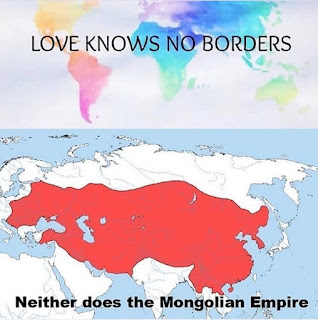The Ruthless Pacifier
Mongol leader Genghis Khan (1162-1227) rose from the ashes of the previous generation to establish the largest interconnected empire in history. After uniting the nomadic tribes of the Mongolian plateau, he was the only one able to successfully conquer major chunks of central Asia and China. His descendants further expanded the empire, advancing to far-off places as Poland, Vietnam, Syria, and Korea. At the peak of their legacy, the Mongols were able to easily control 12 million contiguous square miles, an area around the size of Africa. He was able to grant religious freedom to his subjects, abolish torture, encourage imports and exports, and also created the first international postal system. Genghis Khan made the impossible possible by conquering more than twice as much land as any other person in history, bringing Eastern and Western civilizations into contact in the process.
Did you know? Mongol leader Genghis Khan never allowed anyone to paint his portrait, sculpt his image, or engrave his likeness on a coin. His first image only appeared after his death.
Genghis Khan: The Early Years
The rise of this tyrant began in 1162 near the border between modern Mongolia and Siberia. At that time, dozens of nomadic tribes on the central Asian steppe were constantly under siege, and growing up was violent and scary for Temujin when he was growing up. Before he turned 10, his father was poisoned to death by an enemy clan. Temujin’s clan then deserted him for being too weak, his mother, and his six siblings to avoid having to feed them. This abandonment would play a very vital role in his future to come.
Shortly after, Temujin killed his older half-brother and took over as the head of his poverty-stricken household. In 1178 Temujin married Borte, with whom he would have four sons and an unknown number of daughters. He soon began making alliances, building a reputation as a warrior, and attracted a growing number of followers.
Genghis Khan Uniting the Mongols
Temujin not being a man of customs would put competent allies rather than his relatives in key positions and would also execute the leaders of enemy tribes. By 1205 he had vanquished all of his rivals, including his former best friend Jamuka. The following year, he called a meeting of representatives from every part of the territory and established a nation similar in size to modern Mongolia. He was hence proclaimed Chinggis Khan, which roughly translates to “Universal Ruler,” a name that became known in the West as Genghis Khan.
Having united the steppe tribes, Genghis Khan ruled over some 1 million people. He forbade the selling and kidnapping of women, banned the enslavement of any Mongol, and made livestock theft punishable by death. Moreover, Genghis Khan allowed freedom of religion well before that idea caught on elsewhere.
After a series of raids against the Xi Xia kingdom, the Mongols launched a major initiative in 1209 that brought them to the doorstep of Yinchuan, the Xi Xia capital. Unlike other armies, the Mongols traveled with no supply train other than a large reserve of horses. The army consisted almost entirely of cavalrymen, who were expert riders and deadly with a bow and arrows. At Yinchuan, the Mongols deployed a false withdrawal—one of their signature tactics—and then initiated a siege. Though their attempt to flood the city failed, the Xi Xia ruler submitted and presented tribute.
The Mongols next attacked the Jin Dynasty of northern China, whose ruler had made the foolish mistake of demanding Genghis Khan’s submission. From 1211 to 1214, the outnumbered Mongols ravaged the countryside and sent refugees pouring into the cities. In 1214 the Mongols besieged the capital of Zhongdu (now Beijing), and the Jin ruler agreed to hand over large amounts of silk, silver, gold, and horses.
In 1219 Genghis Khan went to war against the Khwarezm Empire in present-day Turkmenistan, Uzbekistan, Afghanistan, and Iran. Despite once again being outnumbered, the Mongol horde swept through one Khwarezm city after another, including Bukhara, Samarkand, and Urgench. Skilled workers like carpenters and jewelers were usually saved. Unskilled workers, meanwhile, were often used as human shields during the next assault. No one knows with any certainty how many people died during Genghis Khan’s wars, in part because the Mongols propagated their vicious image as a way of spreading terror.
Did you know? Most of what we know about Genghis Khan’s childhood comes from “The Secret History of the Mongols,” the oldest known work of Mongolian history and literature. Most of these records were written several years after his death. Thus, many are not credible sources of information as they are full of made-up, exaggerated incidents or have been rendered unreliable as different versions of the same event are prevalent.
Genghis Khan Establishes an Empire
When Genghis Khan returned to Mongolia in 1225, he controlled a huge swath of territory from the Sea of Japan to the Caspian Sea. Nevertheless, he didn’t rest for long before turning his attention back to the Xi Xia kingdom, which had refused to contribute troops to the Khwarezm invasion. In early 1227 a horse threw Genghis Khan to the ground, causing internal injuries. He pressed on with the campaign, but his health never recovered. He died on August 18, 1227.
Genghis Khan's name automatically inspires an image of a ruler who reigned with impunity. But was he any different from his contemporary rulers? His actions have led to innumerable critics who vilify him though they ought to be careful for they might be one of his 16 million descendants.




Comments
Post a Comment